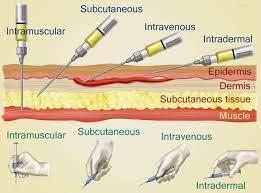The nurse is teaching a client how to self-administer low-molecular-weight heparin subcutaneously. Which instruction should the nurse include?
Massage the injection site to increase absorption.
Rotate injections between the abdomen and gluteal areas.
Expel the air in the prefilled syringe prior to injection.
Inject in abdominal area at least 2 inches from the umbilicus.
The Correct Answer is D
Choice A Reason: Massaging the injection site can cause bruising and bleeding, and is not recommended for subcutaneous heparin injections.
Choice B Reason: Rotating injections between different body sites can increase the risk of hematoma formation and skin irritation, and is not advised for subcutaneous heparin injections.
Choice C Reason: Expelling the air in the prefilled syringe can result in a loss of medication dose, and is not necessary for subcutaneous heparin injections.
Choice D Reason: Injecting in the abdominal area at least 2 inches from the umbilicus is the correct technique for subcutaneous heparin injections, as it reduces the risk of injury to blood vessels and nerves, and ensures consistent absorption of the medication.

Nursing Test Bank
Naxlex Comprehensive Predictor Exams
Related Questions
Correct Answer is D
Explanation
Choice A: Have the client hold a pillow over the abdomen to cough and deep breathe is not the most important instruction because it is not related to repositioning. This is a good practice to prevent respiratory complications after surgery, but it can be done at any time.
Choice B: Encourage the client to eat all of the meals that are sent is not the most important instruction because it is not related to repositioning. This is a good practice to promote nutrition and healing after surgery, but it can be done at any time.
Choice C: Offer fruit juice at least twice during both the day and evening shifts is not the most important instruction because it is not related to repositioning. This is a good practice to prevent dehydration and constipation after surgery, but it can be done at any time.
Choice D: Lower the bed prior to helping the client to move up in bed is the most important instruction because it reduces the risk of injury and falls for both the client and the UAP. This is a safety measure that should be done before any repositioning.
Correct Answer is C
Explanation
Choice A Reason: This is incorrect because instilling normal saline solution into the nasogastric tube can cause fluid overload, electrolyte imbalance, or aspiration. Clamping the tube for one hour can also increase the risk of aspiration and gastric distension.
Choice B Reason: This is incorrect because turning the suction off can cause gastric distension and discomfort. Rinsing the mouth with cool water can also increase the risk of aspiration if the client swallows some of the water.
Choice C Reason: This is correct because oral sponge toothettes are soft and gentle on the oral mucosa and can help moisten and cleanse the mouth without causing irritation or aspiration.
Choice D Reason: This is incorrect because teaching the client that the oral mucosa must remain dry is false and can lead to further dryness, cracking, bleeding, and infection. The oral mucosa should be kept moist and clean to prevent these complications.
Whether you are a student looking to ace your exams or a practicing nurse seeking to enhance your expertise , our nursing education contents will empower you with the confidence and competence to make a difference in the lives of patients and become a respected leader in the healthcare field.
Visit Naxlex, invest in your future and unlock endless possibilities with our unparalleled nursing education contents today
Report Wrong Answer on the Current Question
Do you disagree with the answer? If yes, what is your expected answer? Explain.
Kindly be descriptive with the issue you are facing.
